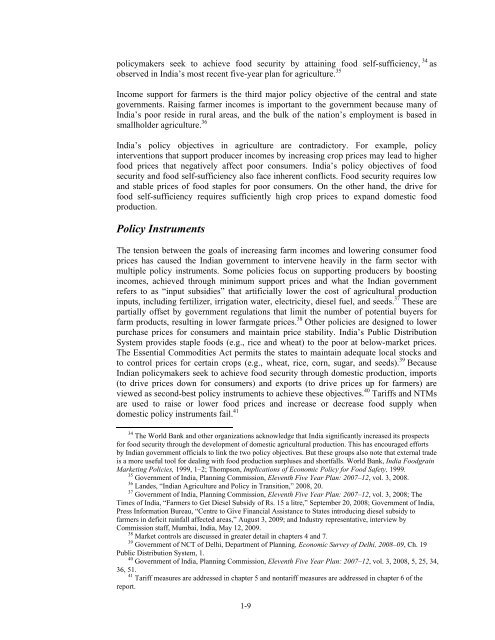India: Effects of Tariffs and Nontariff Measures on U.S. ... - USITC
India: Effects of Tariffs and Nontariff Measures on U.S. ... - USITC
India: Effects of Tariffs and Nontariff Measures on U.S. ... - USITC
You also want an ePaper? Increase the reach of your titles
YUMPU automatically turns print PDFs into web optimized ePapers that Google loves.
policymakers seek to achieve food security by attaining food self-sufficiency, 34 as<br />
observed in <str<strong>on</strong>g>India</str<strong>on</strong>g>’s most recent five-year plan for agriculture. 35<br />
Income support for farmers is the third major policy objective <str<strong>on</strong>g>of</str<strong>on</strong>g> the central <str<strong>on</strong>g>and</str<strong>on</strong>g> state<br />
governments. Raising farmer incomes is important to the government because many <str<strong>on</strong>g>of</str<strong>on</strong>g><br />
<str<strong>on</strong>g>India</str<strong>on</strong>g>’s poor reside in rural areas, <str<strong>on</strong>g>and</str<strong>on</strong>g> the bulk <str<strong>on</strong>g>of</str<strong>on</strong>g> the nati<strong>on</strong>’s employment is based in<br />
smallholder agriculture. 36<br />
<str<strong>on</strong>g>India</str<strong>on</strong>g>’s policy objectives in agriculture are c<strong>on</strong>tradictory. For example, policy<br />
interventi<strong>on</strong>s that support producer incomes by increasing crop prices may lead to higher<br />
food prices that negatively affect poor c<strong>on</strong>sumers. <str<strong>on</strong>g>India</str<strong>on</strong>g>’s policy objectives <str<strong>on</strong>g>of</str<strong>on</strong>g> food<br />
security <str<strong>on</strong>g>and</str<strong>on</strong>g> food self-sufficiency also face inherent c<strong>on</strong>flicts. Food security requires low<br />
<str<strong>on</strong>g>and</str<strong>on</strong>g> stable prices <str<strong>on</strong>g>of</str<strong>on</strong>g> food staples for poor c<strong>on</strong>sumers. On the other h<str<strong>on</strong>g>and</str<strong>on</strong>g>, the drive for<br />
food self-sufficiency requires sufficiently high crop prices to exp<str<strong>on</strong>g>and</str<strong>on</strong>g> domestic food<br />
producti<strong>on</strong>.<br />
Policy Instruments<br />
The tensi<strong>on</strong> between the goals <str<strong>on</strong>g>of</str<strong>on</strong>g> increasing farm incomes <str<strong>on</strong>g>and</str<strong>on</strong>g> lowering c<strong>on</strong>sumer food<br />
prices has caused the <str<strong>on</strong>g>India</str<strong>on</strong>g>n government to intervene heavily in the farm sector with<br />
multiple policy instruments. Some policies focus <strong>on</strong> supporting producers by boosting<br />
incomes, achieved through minimum support prices <str<strong>on</strong>g>and</str<strong>on</strong>g> what the <str<strong>on</strong>g>India</str<strong>on</strong>g>n government<br />
refers to as “input subsidies” that artificially lower the cost <str<strong>on</strong>g>of</str<strong>on</strong>g> agricultural producti<strong>on</strong><br />
inputs, including fertilizer, irrigati<strong>on</strong> water, electricity, diesel fuel, <str<strong>on</strong>g>and</str<strong>on</strong>g> seeds. 37 These are<br />
partially <str<strong>on</strong>g>of</str<strong>on</strong>g>fset by government regulati<strong>on</strong>s that limit the number <str<strong>on</strong>g>of</str<strong>on</strong>g> potential buyers for<br />
farm products, resulting in lower farmgate prices. 38 Other policies are designed to lower<br />
purchase prices for c<strong>on</strong>sumers <str<strong>on</strong>g>and</str<strong>on</strong>g> maintain price stability. <str<strong>on</strong>g>India</str<strong>on</strong>g>’s Public Distributi<strong>on</strong><br />
System provides staple foods (e.g., rice <str<strong>on</strong>g>and</str<strong>on</strong>g> wheat) to the poor at below-market prices.<br />
The Essential Commodities Act permits the states to maintain adequate local stocks <str<strong>on</strong>g>and</str<strong>on</strong>g><br />
to c<strong>on</strong>trol prices for certain crops (e.g., wheat, rice, corn, sugar, <str<strong>on</strong>g>and</str<strong>on</strong>g> seeds). 39 Because<br />
<str<strong>on</strong>g>India</str<strong>on</strong>g>n policymakers seek to achieve food security through domestic producti<strong>on</strong>, imports<br />
(to drive prices down for c<strong>on</strong>sumers) <str<strong>on</strong>g>and</str<strong>on</strong>g> exports (to drive prices up for farmers) are<br />
viewed as sec<strong>on</strong>d-best policy instruments to achieve these objectives. 40 <str<strong>on</strong>g>Tariffs</str<strong>on</strong>g> <str<strong>on</strong>g>and</str<strong>on</strong>g> NTMs<br />
are used to raise or lower food prices <str<strong>on</strong>g>and</str<strong>on</strong>g> increase or decrease food supply when<br />
domestic policy instruments fail. 41<br />
34 The World Bank <str<strong>on</strong>g>and</str<strong>on</strong>g> other organizati<strong>on</strong>s acknowledge that <str<strong>on</strong>g>India</str<strong>on</strong>g> significantly increased its prospects<br />
for food security through the development <str<strong>on</strong>g>of</str<strong>on</strong>g> domestic agricultural producti<strong>on</strong>. This has encouraged efforts<br />
by <str<strong>on</strong>g>India</str<strong>on</strong>g>n government <str<strong>on</strong>g>of</str<strong>on</strong>g>ficials to link the two policy objectives. But these groups also note that external trade<br />
is a more useful tool for dealing with food producti<strong>on</strong> surpluses <str<strong>on</strong>g>and</str<strong>on</strong>g> shortfalls. World Bank, <str<strong>on</strong>g>India</str<strong>on</strong>g> Foodgrain<br />
Marketing Policies, 1999, 1–2; Thomps<strong>on</strong>, Implicati<strong>on</strong>s <str<strong>on</strong>g>of</str<strong>on</strong>g> Ec<strong>on</strong>omic Policy for Food Safety, 1999.<br />
35 Government <str<strong>on</strong>g>of</str<strong>on</strong>g> <str<strong>on</strong>g>India</str<strong>on</strong>g>, Planning Commissi<strong>on</strong>, Eleventh Five Year Plan: 2007–12, vol. 3, 2008.<br />
36 L<str<strong>on</strong>g>and</str<strong>on</strong>g>es, “<str<strong>on</strong>g>India</str<strong>on</strong>g>n Agriculture <str<strong>on</strong>g>and</str<strong>on</strong>g> Policy in Transiti<strong>on</strong>,” 2008, 20.<br />
37 Government <str<strong>on</strong>g>of</str<strong>on</strong>g> <str<strong>on</strong>g>India</str<strong>on</strong>g>, Planning Commissi<strong>on</strong>, Eleventh Five Year Plan: 2007–12, vol. 3, 2008; The<br />
Times <str<strong>on</strong>g>of</str<strong>on</strong>g> <str<strong>on</strong>g>India</str<strong>on</strong>g>, “Farmers to Get Diesel Subsidy <str<strong>on</strong>g>of</str<strong>on</strong>g> Rs. 15 a litre,” September 20, 2008; Government <str<strong>on</strong>g>of</str<strong>on</strong>g> <str<strong>on</strong>g>India</str<strong>on</strong>g>,<br />
Press Informati<strong>on</strong> Bureau, “Centre to Give Financial Assistance to States introducing diesel subsidy to<br />
farmers in deficit rainfall affected areas,” August 3, 2009; <str<strong>on</strong>g>and</str<strong>on</strong>g> Industry representative, interview by<br />
Commissi<strong>on</strong> staff, Mumbai, <str<strong>on</strong>g>India</str<strong>on</strong>g>, May 12, 2009.<br />
38 Market c<strong>on</strong>trols are discussed in greater detail in chapters 4 <str<strong>on</strong>g>and</str<strong>on</strong>g> 7.<br />
39 Government <str<strong>on</strong>g>of</str<strong>on</strong>g> NCT <str<strong>on</strong>g>of</str<strong>on</strong>g> Delhi, Department <str<strong>on</strong>g>of</str<strong>on</strong>g> Planning, Ec<strong>on</strong>omic Survey <str<strong>on</strong>g>of</str<strong>on</strong>g> Delhi, 2008–09, Ch. 19<br />
Public Distributi<strong>on</strong> System, 1.<br />
40 Government <str<strong>on</strong>g>of</str<strong>on</strong>g> <str<strong>on</strong>g>India</str<strong>on</strong>g>, Planning Commissi<strong>on</strong>, Eleventh Five Year Plan: 2007–12, vol. 3, 2008, 5, 25, 34,<br />
36, 51.<br />
41 Tariff measures are addressed in chapter 5 <str<strong>on</strong>g>and</str<strong>on</strong>g> n<strong>on</strong>tariff measures are addressed in chapter 6 <str<strong>on</strong>g>of</str<strong>on</strong>g> the<br />
report.<br />
1-9

















